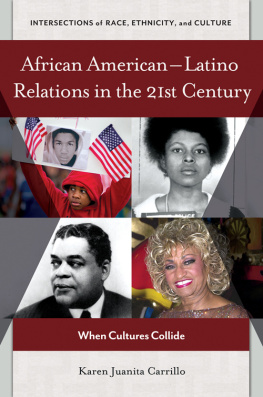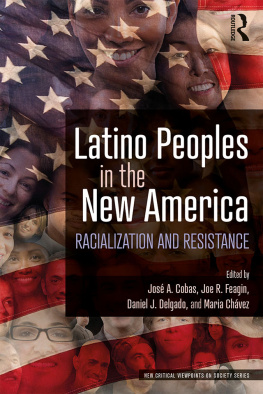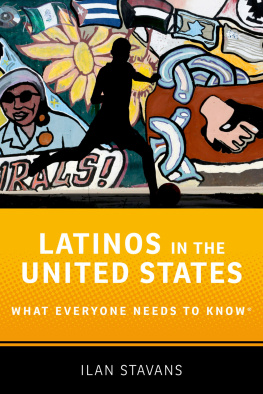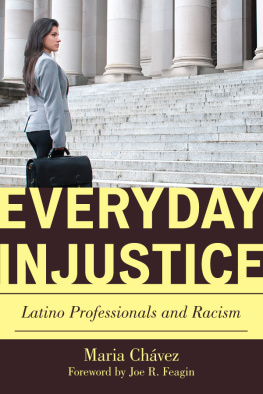African AmericanLatino
Relations in the 21st Century
Recent Titles in
Intersections of Race, Ethnicity, and Culture
Revolvers and Pistolas, Vaqueros and Caballeros: Debunking the Old West
D.H. Figueredo
Finding Baseballs Next Clemente: Combating Scandal in Latino Recruiting
Roger Bruns
Color Stories: Black Women and Colorism in the 21st Century
JeffriAnne Wilder
The Healing Power of Hip Hop
Raphael Travis Jr.
Dangerous Spaces: Beyond the Racial Profile
D. Marvin Jones
African AmericanLatino Relations in the 21st Century
When Cultures Collide

Karen Juanita Carrillo
Intersections of Race, Ethnicity, and Culture
Gary Y. Okihiro, Series Editor

Copyright 2017 by Karen Juanita Carrillo
All rights reserved. No part of this publication may be reproduced, stored in a retrieval system, or transmitted, in any form or by any means, electronic, mechanical, photocopying, recording, or otherwise, except for the inclusion of brief quotations in a review, without prior permission in writing from the publisher.
Library of Congress Cataloging-in-Publication Data
Names: Carrillo, Karen Juanita, author.
Title: African American-Latino relations in the 21st century : when cultures collide / Karen Juanita Carrillo.
Description: Santa Barbara, California : Praeger, 2017. | Series: Intersections of race, ethnicity, and culture | Includes bibliographical references and index.
Identifiers: LCCN 2016059979 (print) | LCCN 2017018242 (ebook) | ISBN 9781440829628 (ebook) | ISBN 9781440829611 (alk. paper)
Subjects: LCSH: African AmericansRelations with Hispanic Americans. | United StatesRace relations21st century.
Classification: LCC E185.615 (ebook) | LCC E185.615 .C3516 2017 (print) | DDC 305.800973dc23
LC record available at https://lccn.loc.gov/2016059979
ISBN: 978-1-4408-2961-1
EISBN: 978-1-4408-2962-8
21 20 19 18 17 1 2 3 4 5
This book is also available as an eBook.
Praeger
An Imprint of ABC-CLIO, LLC
ABC-CLIO, LLC
130 Cremona Drive, P.O. Box 1911
Santa Barbara, California 93116-1911
www.abc-clio.com
This book is printed on acid-free paper 
Manufactured in the United States of America
Contents
Series Foreword
Intersectionality, named by critical race scholar Kimberl Crenshaw in 1989, references the multiple and conjoining forces that constrain and oppress all peoples. Two decades before Crenshaws articulation, activist Frances Beale organized the Black Womens Alliance and then the Third World Womens Alliance to mobilize against the racism, sexism, heterosexism, and classism faced by women of color in the United States. Critically important was Beales recognition that African Americans, American Indians, Asian Americans, and Latinas comprised a collective group, across racialized divides, as women of color or in the parlance of the 1960s and 1970s, Third World women. The wider term linked the condition of women of color in the United States with women in Africa, Asia, and the Caribbean and Latin America.
African American women of the Combahee River Collective, a black feminist group formed in Boston in 1974, best described what Crenshaw later called intersectionality. We are committed, the Combahee River Statement declared in April 1977, to struggling against racial, sexual, heterosexual, and class oppression, and see as our particular task the development of integrated analysis and practice based upon the fact that the major systems of oppression are interlocking. The synthesis of those oppressions creates the conditions of our lives. Significantly, the theorists of the Collective observed from their everyday life experiences that the forces that oppressed them were systematic and intersecting. They were not random but organized and not additive as in racism plus sexism plus heterosexism but relational and overlapping as in gendered races, sexualized genders, and so forth.
The power of those analyses and practices must not escape us in the 21st century. They are as fresh and vital as when they were first experienced and theorized. This series, Intersections of Race, Ethnicity, and Culture, aspires to continue and extend the struggles against all forms of oppression. Our authors understand the past as prologue, and they offer fresh perspectives to contemporary social issues in highly accessible language. Moreover, our authors present engagements beyond the white-nonwhite binary to relations among peoples of color and enlarge upon the U.S. social formation as race but also and simultaneously gender, sexuality, class, and nation. Finally, their studies show how peoples of color cast a different light on the United States, revealing the nation in its fullness and verity.
People of color have reshaped America fundamentally, and we establish that claim in this series.
Gary Y. Okihiro
Preface
My grandfather, my fathers father, was from the Puerto Rican island of Vieques. Teodoro Carrillo Cardona is the little balding man I see in sepia-toned old family photographs. Its a funny story: strange, funny. How my grandfather, this little black man, this guy who was not very tall at all, how he was from Vieques and how he loved to cook. Its funny, and its not much, but its what I know of him.
When I was growing up in the 1970s, everybody I knew was taught to take pride in his or her ethnicity. The adults I knew always talked to me about the importance of understanding my heritage. I learned that my mothers family was composed of Africans who could trace their heritage as far as the U.S. state of Georgia, where theyd also had some intermarriage with the indigenous Creek tribe. They were forced to leave Georgia in the 1940s after becoming too financially successfulwhich was tantamount to a crime for blacks in Georgia at that time.
My fathers family was made up of AfroPuerto Ricans who came to the New York City area looking to take advantage of Puerto Ricos new association with the United States. Puerto Rico became a possession of the United States in 1898, and ever since then the island has had to struggle to find employment for its residents. There were few jobs thereparticularly for blacksso my grandfather moved his family here, just so they could survive.
When my abuelo moved his family here, it changed their lives. They were black Puerto Ricans. In Puerto Rico, census takers had often classified lighter-skinned blacks as whiteit was a way to boost the idea that there was a large white population on the island. But my abuelo, Teodoro, never accepted that. Although his family was treated better when they identified as Puerto Rican whites, Teodoro refused that lie about his family. They knew who they were, knew their heritage. But here in the States, they would have to reinforce that choice; they had to choose a racial allegiance based on their ethnic heritage. Teodoro accepted his life as that of a black man in the United States.
I was raised with a strong sense of pride in being of African American and AfroPuerto Rican descent. It was such a shock to me as I grew up to encounter people who did not feel this same way about their African lineage. Or to meet HispanicsPuerto Ricans in particularwho wanted me to prove my heritage because I did not fit into their image of what a Puerto Rican should look like. If my hair wasnt slightly curly, and my skin wasnt a cream-based brown, how could I claim Puerto Rican heritage?
Next page









